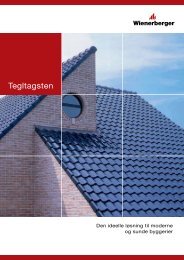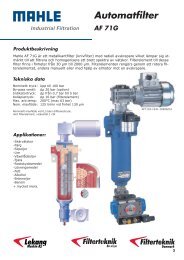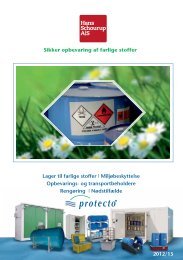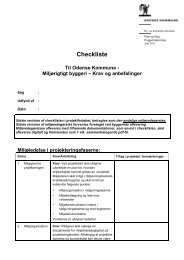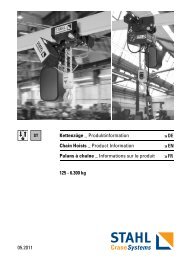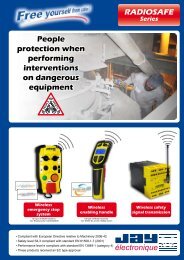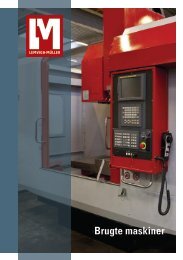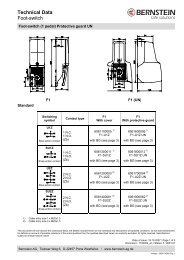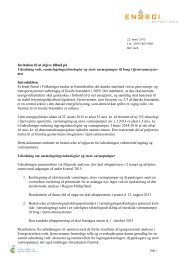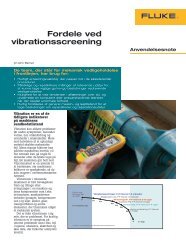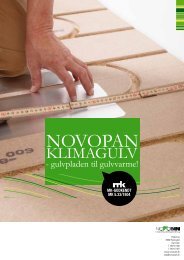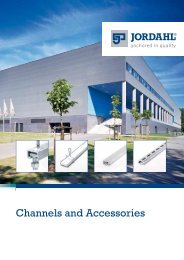Lufft OPUS20 LAN-Datalogger Future Inside - Fisher UK Extranet
Lufft OPUS20 LAN-Datalogger Future Inside - Fisher UK Extranet
Lufft OPUS20 LAN-Datalogger Future Inside - Fisher UK Extranet
You also want an ePaper? Increase the reach of your titles
YUMPU automatically turns print PDFs into web optimized ePapers that Google loves.
Wherever measured data is transferred<br />
by means of <strong>LAN</strong> within industry, <strong>Lufft</strong>‘s<br />
<strong>OPUS20</strong> datalogger family can be ideally<br />
applied everywhere!<br />
With <strong>OPUS20</strong>, each ethernet cabable<br />
datalogger can be provided with an IP<br />
address even in remote monitoring networks,<br />
where many dataloggers are in operation.<br />
We see <strong>LAN</strong>, in connection with professional<br />
industrial applications with the highest<br />
reliability, as being the best possible data<br />
transfer method as opposed to W<strong>LAN</strong><br />
applications that do not provide 100% data<br />
security during data transfer.<br />
Furthermore, power can be supplied via <strong>LAN</strong><br />
(PoE) with the built-in batteries operating as<br />
a UPS (uninterruptible power supply).<br />
For these reasons this device<br />
concept corresponds to our development<br />
philosophy –<br />
“<strong>Future</strong> <strong>Inside</strong>”<br />
Measurement<br />
Storage and Transfer<br />
Representation and Evaluation<br />
Qualification and Calibration<br />
Alarm<br />
<strong>Lufft</strong> <strong>OPUS20</strong><br />
<strong>LAN</strong>-<strong>Datalogger</strong><br />
<strong>Future</strong> <strong>Inside</strong><br />
a passion for precision · passion pour la précision · pasión por la precisión · passione per la precisione · a<br />
T<br />
01<br />
22<br />
01<br />
IE<br />
G. LUFFT<br />
Mess- und Regeltechnik GmbH<br />
Gutenbergstrasse 20<br />
70736 Fellbach<br />
Postfach 4252<br />
70719 Fellbach<br />
Tel. +49 (0)711- 51822 - 0<br />
Fax +49 (0)711- 51822 - 41<br />
www.lufft.de<br />
info@lufft.de<br />
Subject to technical modifications <strong>Lufft</strong> <strong>OPUS20</strong> · 10.2011<br />
www.lufft.com
The world’s toughest<br />
legal guidelines: 21<br />
CFR Part 11<br />
(electronic records).<br />
The pharmaceutical<br />
industry trusts in <strong>Lufft</strong>.<br />
Today’s industrial data acquisition generally takes place in real time. The conditions and process<br />
environments of measured values regarding room climate change slowly, but are, nevertheless,<br />
permanent. Therefore, modern data recording systems that are implemented in this industry<br />
have to be reliable like <strong>Lufft</strong> products. Our products feature the following characteristics:<br />
modular design, a flexible and expandable sensor archive, freely programmable representation<br />
of measured values, as well as a monitoring system that is precisely tailored to the respective requirements<br />
and reacts as quickly as possible to potential nonconformities by setting off an alarm.<br />
Rule out Fatal<br />
Keep<br />
Consequences<br />
Threshold<br />
Values in<br />
Check<br />
The performance and quality of the whole data acquisition<br />
system is determined by measurement. Each<br />
application requires the ideal sensor for the job, and for<br />
this reason we offer several sensors – according to specification<br />
and area of application – for identical measuring<br />
categories. While a customer, for example, implicitly<br />
requires sensors in a steel housing, another application<br />
might necessitate the need for a differential pressure sensor<br />
with display. Due to our experience in various projects<br />
we are not only able to recommend,<br />
when it comes to sensors,<br />
the best possible solution for each<br />
application to our customers, but<br />
we also possess a variety of alternatives<br />
so that each user can find<br />
the ideal product.<br />
Data storage naturally takes<br />
place in the central computer where<br />
data is collected at its collection<br />
point in real time. What happens<br />
if the system crashes? In cases of<br />
maximum data security we have<br />
integrated data logger modules<br />
in the measurement chain. These<br />
are situ ated between the sensor<br />
Storage and<br />
Transfer<br />
and the central computer and represent a type of “Hammock”.<br />
If the central computer does not receive all the<br />
data, then the data can be read “offline” and transferred<br />
from the temporary storage devices (data loggers).<br />
Nowadays modern data logging systems are independent<br />
of measurement rates, or rather measurement clocks.<br />
The data loggers establish an average value per sensor<br />
according to the user’s requirements. With particle sensors<br />
this is the total sum per time unit.<br />
Qualification completes the successful system implementation<br />
procedure; calibration ensures an error-free<br />
and long-term precise operation. In summary, the best<br />
solution is based on two conditions: the first of which<br />
is the complete information of the customer’s requirements,<br />
the other being a flexible system representing<br />
the customer’s demands. For more detailed information<br />
concerning our procedures and what measurements you<br />
can yield, please consult our technical description. At the<br />
same time we provide a long-term<br />
traceability of processes.<br />
Qualification<br />
and<br />
Calibration<br />
Measurement<br />
Representation<br />
and<br />
Evaluation<br />
Representation and evaluation<br />
is carried out by the<br />
software’s client/server structure,<br />
allowing users to access and obtain<br />
relevant data.<br />
For many pharmaceutical and<br />
Alarm<br />
clean room applications the most<br />
important link in the chain is the<br />
alarm. Ultimately, it is imperative<br />
to act immediately to any possible<br />
deviations and take appropriate<br />
action.<br />
It is essential, for example, that processes such as “longterm<br />
stability tests” or clean room production be put right<br />
straight away if an error in the process chain arises.<br />
In industry, data transfer is sent analogically to a computer<br />
in the network. Due to the technical ZERTIFIZIERT connection<br />
with the IP Network, data recording sites DIN each EN receive ISO 9001 an<br />
IP address and are linked by means of NR existing 70100F222 network<br />
architecture.<br />
DKD-K-26701<br />
CERTIFIE<br />
3
Measurement<br />
Measurement<br />
<strong>Lufft</strong> <strong>OPUS20</strong> Functions<br />
<strong>Lufft</strong> <strong>OPUS20</strong> THI<br />
Temperature and rel. Humidity<br />
Functions<br />
THI<br />
8120.00<br />
THIP<br />
8120.10<br />
TCO<br />
8120.20<br />
<strong>Lufft</strong><br />
<strong>OPUS20</strong> E<br />
8120.30<br />
Power supply battery • • • •<br />
Power supply USB • • • •<br />
Power supply <strong>LAN</strong> (POE) optional optional optional optional<br />
Measured data storage 3,200,000 3,200,000 3,200,000 3,200,000<br />
Typical battery life > 1 year > 1 year > 4 months > 4 months<br />
LC-display • • • •<br />
One-button operation • • • •<br />
1-point calibration by user/operator • • • •<br />
°C/°F switchable • • • •<br />
Optical/acoustical alarm • • • •<br />
Date/time • • • •<br />
Records Min/Max/Avg. • • • •<br />
SmartGraph 3 evaluation software • • • •<br />
Measurement Categories<br />
THI<br />
8120.00<br />
THIP<br />
8120.10<br />
TCO<br />
8120.20<br />
<strong>Lufft</strong><br />
<strong>OPUS20</strong> E<br />
8120.30<br />
Temperature<br />
Air temperature • • • • *<br />
PT100 • **<br />
Thermocpuple • **<br />
Humidity<br />
Relative humidity • • • • *<br />
Absolute humidity • • • • *<br />
Dew point temperature • • • • *<br />
Mixture ratio • *<br />
Air pressure<br />
Barometric air pressure • • *<br />
Relative air pressure • • *<br />
CO 2<br />
Concentration<br />
CO 2<br />
Concentration<br />
•<br />
External digital UMB Bus Sensor<br />
TFF20 • *<br />
External analog Input<br />
Sensor input voltage • ***<br />
Sensor input electric current • ***<br />
Function Table Software<br />
THI<br />
8120.00<br />
THIP<br />
8120.10<br />
TCO<br />
8120.20<br />
<strong>Lufft</strong><br />
<strong>OPUS20</strong> E<br />
8120.30<br />
<strong>Lufft</strong> Opus20 Temperature and Relative Humidity<br />
Order-No.<br />
<strong>Lufft</strong> Opus20 Temperature / rel. Humidity (neutral without <strong>Lufft</strong>-Logo 8120.00N) 8120.00<br />
<strong>Lufft</strong> Opus20 Temperature / rel. Humidity PoE (neutral without <strong>Lufft</strong>-Logo 8120.01N) 8120.01<br />
Technical data Dimensions length. 166 mm, width 78 mm, depth 32mm<br />
Measurement rate 10/30s, 1/10/12/15/30min, 1/3/6/12/24h<br />
Construction<br />
plastic housing<br />
Operation life (battery) > 1 Year<br />
Data storage<br />
16 MB, 3,200,000 measured values<br />
LC-Display<br />
size 90x64 mm<br />
Weight<br />
approx. 250g<br />
Included in delivery PC-Windows Software SmartGraph 3<br />
for graphical and numerical representation<br />
of measured values / instruction manual/<br />
data cable / battery<br />
Interface<br />
USB, <strong>LAN</strong><br />
Storage rate<br />
1/10/12/15/30min, 1/3/6/12/24h<br />
Power supply<br />
4 x LRG AA Mignon, USB, (POE opt.)<br />
Max. operation<br />
-20...50°C<br />
temperature<br />
Max. rel. humidity 0...95%r.h.
Measurement<br />
Measurement<br />
<strong>Lufft</strong> <strong>OPUS20</strong> THIP Temperature,<br />
Rel. Humidity, Air Pressure<br />
<strong>Lufft</strong> Opus20 TCO<br />
Temperature, Rel. Humidity, CO 2<br />
Finally available: <strong>Lufft</strong>’s precise<br />
weather station for interior applications<br />
– an essential data collector for all<br />
calibration laboratories.<br />
<strong>Lufft</strong> <strong>OPUS20</strong> THIP Temperature, Relative Humidity, Air Pressure<br />
Order-No.<br />
<strong>Lufft</strong> <strong>OPUS20</strong> THIP Temperature / Rel. Humidity / Air Pressure<br />
(neutral without <strong>Lufft</strong>-Logo 8120.10N)<br />
8120.10<br />
<strong>Lufft</strong> <strong>OPUS20</strong> THIP Temperature / Rel. Humidity / Air Pressure PoE<br />
(neutral without <strong>Lufft</strong>-Logo 8120.11N)<br />
8120.11<br />
Technical data Dimensions length. 166 mm, width 78 mm, depth 32mm<br />
Measurement rate 10/30s, 1/10/12/15/30min, 1/3/6/12/24h<br />
Construction<br />
plastic housing<br />
Operation life (battery) > 1 Year<br />
Data storage<br />
16 MB, 3,200,000 measured values<br />
LC-Display<br />
size 90x64 mm<br />
Weight<br />
approx. 250g<br />
Included in delivery PC-Windows Software SmartGraph 3<br />
for graphical and numerical representation<br />
of measured values / instruction manual/<br />
data cable / battery<br />
Interface<br />
USB, <strong>LAN</strong><br />
Storage rate<br />
1/10/12/15/30min, 1/3/6/12/24h<br />
Power supply<br />
4 x LRG AA Mignon, USB, (POE opt.)<br />
Max. operation<br />
-20...50°C<br />
temperature<br />
Max. rel. humidity 0...95%r.h. 4 month<br />
Data storage<br />
16 MB, 3,200,000 measured values<br />
LC-Display<br />
size 90x64 mm<br />
Weight<br />
approx. 250g<br />
Included in delivery PC-Windows Software SmartGraph 3<br />
for graphical and numerical representation<br />
of measured values / instruction manual/<br />
data cable / battery<br />
Interface<br />
USB, <strong>LAN</strong><br />
Storage rate<br />
1/10/30min, 1/3/6/12/24h<br />
Power supply<br />
4 x LRG AA Mignon, USB, (POE opt.)<br />
Max. operation<br />
-20...50°C<br />
temperature<br />
Max. rel. humidity 0...95%r.F.
Representation<br />
and<br />
Evaluation<br />
SmartGraph3 Software<br />
With SmartGraph3 the gathering<br />
of measured data is simple and as<br />
intuitive as possible:<br />
software<br />
• An Opus20 datalogger is automatically<br />
recognised and added as a “network<br />
device”.<br />
• In addition to its data-readout function,<br />
the software possesses a recording mode<br />
that enables parallel recording to be<br />
displayed on the computer.<br />
• The data from any desired number<br />
of <strong>OPUS20</strong> devices can be read out<br />
simultaneously.<br />
• The zoom function allows for quick<br />
analysis of critical time periods.<br />
• The exporting of measured data in<br />
csv format enables it to be imported<br />
into Excel.<br />
• The device configuration can be<br />
printed out in order to check installation<br />
parameters.<br />
• Alarm limits – like the measured data<br />
– are chronologically managed at various<br />
times so that when changes in alarm<br />
limits occur, they can be retraced.<br />
• Automatic data readout of all<br />
measured data is supported.<br />
9
Measurement<br />
The triple point of water<br />
(balance of all 3 physical<br />
states solid, liquid and<br />
gas) is used to represent<br />
the International<br />
Temperature Scale and<br />
for the highest precision<br />
of temperature measurements<br />
in the milli-Kelvin<br />
range.<br />
Measurement<br />
Highly Sensitive<br />
Measuring is not just measuring.<br />
Each application and application<br />
area requires the ideal sensor.<br />
Apart from this, it is imperative<br />
in the pharmaceutical production<br />
and food industry that the<br />
hundreds of guidelines in place<br />
are adhered to and a multitude of<br />
inspections conducted. Only then<br />
can long-lasting international<br />
standards be guaranteed. <strong>Lufft</strong><br />
can help you fulfil all such criteria<br />
and find the right product.<br />
Humidity Measurements Special<br />
measuring conditions require special sensors.<br />
In most cases only stainless steel<br />
sensors are permitted in clean rooms.<br />
Ideally, these sensors have corrosive free<br />
connector inserts between the elec tronics<br />
and sensor head. On the other hand, in<br />
explosion-proof areas a sensor with a<br />
specially designed power supply is applicable:<br />
in this “zone-zero application” the<br />
electronics for the transmitter are mostly<br />
mounted outside the critical area.<br />
Normal humidity measuring in a clean<br />
room essentially provides sensors with a<br />
“stress-free climate” as opposed to “longterm<br />
stability tests” where equipment<br />
is tested under tropical conditions. It is<br />
important, however, to complete a basic<br />
calibration of the sensors on site and if<br />
necessary, carry out the unproblematic replacement<br />
of equipment.<br />
Incidentally, each precise humidity measurement<br />
requires a parallel temperature<br />
measurement. Only by using this method<br />
are you guaranteed the best possible results.<br />
Air Temperature No rules without<br />
exceptions: in certain cases a combined<br />
temperature/humidity sensor makes little<br />
sense. This especially applies to refrigerators<br />
with extremely low temperatures.<br />
Such ranges require various sensor designs<br />
with the smallest possible diameter<br />
in order to acquire precise temperature<br />
measurements. Take for instance the<br />
PT100 Sensors with a measuring range of<br />
up to -100 °C.<br />
Air Flow is one of the parameters<br />
that needs to be monitored – especially<br />
in highly sterile filling processes (the socalled<br />
Zone A). The Good Manufacturing<br />
Practices (GMP) rules released by the FDA<br />
state that air flow speed has to be 0.45 m/s<br />
± 20 % in any area.<br />
Differential Pressure A minimal<br />
amount of excess pressure is used when<br />
working in sterile environments such as<br />
in hospital operating theatres or in clean<br />
room applications. By means of excess<br />
pressure it is, to some extent, possible<br />
to separate up to 3 or 4 different internal<br />
levels by their particles.<br />
The trick to this process is to keep the differential<br />
pressure as low as possible. As a<br />
result the requirements for the recording<br />
equipment (transmitter) are very high: in<br />
addition to a very good long-term stabi lity,<br />
the transmitters have to be precise and<br />
able to detect the smallest fluctuations in<br />
values, because even a minimal devi ation<br />
of the transmitter can cause problems<br />
with the alarm process. Since differential<br />
pressure is always meas ured against a<br />
reference norm (the so-called “zero point”<br />
– normally the pressure around the production<br />
room), sensors with displays are<br />
mostly used in order to make the zeropoint<br />
adjustment easier.<br />
Particles In pharmaceutical manufacturing,<br />
for example, equipment is mounted<br />
in the filling areas that sucks all particles<br />
by means of a pump and transfers these<br />
to the actual measuring unit. Here, the<br />
particles are put through particle sensors<br />
which numerically measure and register<br />
the size of the particles for a defined<br />
period of time.<br />
While the pharmaceutical industry typ ically<br />
distinguishes between particles of 0.5 to<br />
5 micrometres, the requirements in the<br />
semiconductor industry are con siderably<br />
higher. Here, particles sizes of 0.3 to 0.5<br />
micrometres are detected.<br />
CO 2<br />
In the research areas of the pharmaceutical<br />
industry and in universities, the<br />
internal conditions of the human body<br />
are simulated in incubators. In addition<br />
to the 37 °C ambient temperature and<br />
the relative humidity of more than 90 %<br />
there is a high concentration of CO 2<br />
. This<br />
concentration is between 5 % and 10 %.<br />
In comparison: in normal indoor air applications<br />
the CO 2<br />
concentration, measured<br />
in ppm (Parts per Million), is usually under<br />
1,000 ppm, or rather 0.1 % CO 2<br />
. In school<br />
classrooms these values can be up to<br />
3,000 ppm, which can lead to concentration<br />
disorders.<br />
Sensors that are placed in incubators<br />
should have long-term stability and be<br />
easy to check on site by using a calibration<br />
standard.<br />
11
Measurement<br />
Measurement<br />
Temperature/Humidity Sensors<br />
Air Temperature/CO 2<br />
Temperature/Humidity Sensors<br />
Order-No.<br />
Sensor in plastic housing, plug-in design with gold contacts, easily replaceable,<br />
sinter filter for high protection of sensor<br />
8120.TFF<br />
Rel. Humidity Principle capacitive<br />
Measuring range 0 ...100 % rh.<br />
Accuracy ±2 %<br />
Temperature Principle PT1000, Class A<br />
Measuring range –40… 80 °C<br />
Accuracy<br />
±0.2 ° C<br />
Accessories Cable 2m 8120.KAB2<br />
Cable 10m 8120.KAB10<br />
Y-Connector<br />
8120.STY<br />
Air Temperature<br />
PT100 Temperature Sensor with 10m cable<br />
PT100 Temperature Sensor with 50m cable<br />
Temperature Principle PT100<br />
Measuring range –50… 150 ° C<br />
Accuracy<br />
Class A<br />
Order-No.<br />
8160.TF<br />
8160.TF50<br />
Temperature/Humidity Sensors Stainless Steel<br />
Order-No.<br />
Sensor in stainless steel housing, plug-in design with gold contacts,<br />
easily replaceable, sinter filter for high protection of sensor<br />
8120.TFFE<br />
Rel. Humidity Principle capacitive<br />
Measuring range 0 ...100 % r. F.<br />
Accuracy ±2 %<br />
Temperature Principle PT1000, Class A<br />
Measuring range –40… 80 °C<br />
Accuracy<br />
±0.2 ° C<br />
Accessories Cable 2m 8120.KAB2<br />
Cable 10m 8120.KAB10<br />
Y-Connector<br />
8120.STY<br />
Surface Temperature<br />
PT100 Temperature Sensor with 10m cable<br />
PT100 Temperature Sensor with 50m cable<br />
Temperature Principle PT100<br />
Measuring range –100… 100 ° C<br />
Accuracy<br />
Class A<br />
Order-No.<br />
8160.TFLT<br />
8160.TFLT50<br />
CO 2<br />
Order-No.<br />
Reliable CO 2<br />
transmitter with on-site calibration possibilities 8520.02<br />
CO 2<br />
Principle Infra-red absorber<br />
Measuring range 0..10,000ppm<br />
Output signal<br />
4...20mA<br />
Accuracy<br />
0...10,000ppm: ± (100ppm + 5% of the<br />
measured value)<br />
Power supply<br />
24V AC/DC<br />
Accessories Power supply adapter 8366.USV1<br />
Further information about our products can be found<br />
Further information about our products can be found<br />
12 on our website www.lufft.com<br />
on our website www.lufft.com<br />
13
Measurement<br />
messen<br />
Measurement<br />
Air Flow<br />
Differential Pressure<br />
Air Flow<br />
Order-No.<br />
Differential Pressure<br />
Order-No.<br />
Well-priced air flow transmitter for heating, cooling and ventilation applications 5613.00<br />
Principle<br />
Heated thin film layer<br />
Measuring range<br />
0...20m/s<br />
Response time<br />
t90: typically 4s (at 10m/s)<br />
Outputs<br />
0...10V, 4...20mA<br />
Accuracy<br />
1... 20m/s: ±(0.4m/s + 6% of<br />
measured value)<br />
Power supply 24V AC/DC ±20%<br />
Well-priced and reliable differential pressure sensor for installation in the control<br />
panel, with automatic zero point traceability<br />
2191.100B<br />
Principle<br />
Micro mechanical<br />
Measuring range<br />
- 100 Pa... +100 Pa<br />
Accuracy<br />
0.8 % of measured value<br />
Output<br />
4...20mA<br />
Power supply<br />
12V DC<br />
Option: Measuring range 0...100Pa 2191.100<br />
Air Flow<br />
Order-No.<br />
Well-priced air flow transmitter in plastic housing for clean room applications 5617.00<br />
Principle<br />
Measuring range<br />
Response time<br />
Outputs<br />
Accuracy<br />
Power supply<br />
Heated thin film layer<br />
0 …1 m/s, 0 …1.5 m/s, 0 …2 m/s<br />
t90: typically 4s (at 1m/s)<br />
0...10V, 4...20mA<br />
0.2... 2m/s:<br />
±(0.08m/s +4% of measured value)<br />
19...29V DC<br />
Particle<br />
Air Flow<br />
High-precision air flow transmitter in stainless steel, L-shaped design (laminar flow)<br />
Principle<br />
Hot wire<br />
Measuring range<br />
0 … 1 m/s<br />
Accuracy<br />
±(0.06 m/s + 10 % of measured value)<br />
Outputs<br />
4...20mA<br />
Power supply<br />
24V DC<br />
Order No.<br />
8380.00<br />
stainless<br />
steel<br />
Particle Counter (Pharmaceutical)<br />
Counts particles in the 0.5 and 5 micron size range; pump and sensor<br />
in seperate housing<br />
Dimensions (w x d x h)<br />
13.56 x 8.13 x 10.87 cm<br />
Weight<br />
0.68 Kg<br />
Power consumption<br />
9...28V DC<br />
Operating temperature<br />
10 to 32 °C (50 to 90 °F)<br />
Signal Output Ethernet<br />
Analog 4-20mA (dual mode)<br />
Particle sizes 0.5 µm and 5.0 µm<br />
Flow rate<br />
1.0 CFM (28.3 LPM)<br />
Order-No.<br />
2195.00<br />
Metone<br />
Air Flow<br />
High-precision air flow transmitter in stainless steel housing<br />
(rod module for installation at work stations)<br />
Principle<br />
Hot wire<br />
Measuring range<br />
0 … 1 m/s<br />
Accuracy<br />
±(0.06 m/s + 10 % of measured value)<br />
Outputs<br />
4...20mA<br />
Power supply<br />
24V DC<br />
Order No.<br />
8380.01<br />
stainless<br />
steel<br />
Further information about our products can be found<br />
Further information about our products can be found<br />
14 on our website www.lufft.com<br />
on our website www.lufft.com<br />
15
Storage and<br />
Transfer<br />
Not all offered solutions<br />
contain a temporary<br />
storage device.<br />
<strong>Lufft</strong>: with its experience<br />
the more intelligent<br />
solution.<br />
Storage<br />
Reliable<br />
and<br />
Transfer<br />
The system is simple; <strong>Lufft</strong> Data<br />
Loggers store and transfer data.<br />
One could also say that it is<br />
simply ingenious! From a technical<br />
point of view, it is optimally<br />
engineered and highly reliable.<br />
Starting with the first measurement<br />
transmitted through intelligent<br />
sensors to a temporary data<br />
storage device, up to the transfer<br />
of the measured values to the<br />
central computer: perfect data<br />
transfer, because process stability<br />
is <strong>Lufft</strong>’s number one priority.<br />
Storage<br />
In a measurement chain, an intelligent,<br />
digital or analogue sensor transfers<br />
measure ment data to the processing station.<br />
It is, in fact, technically possible to<br />
store the data directly in the central computer;<br />
however, faults that occur during<br />
the data transfer would then result in a<br />
loss of data.<br />
It is for this reason that <strong>Lufft</strong> uses temporary<br />
storage devices for monitoring<br />
systems that require the highest level of<br />
reliability. These storage devices, or socalled<br />
‘data logger modules’, record the<br />
measured values directly at the sensors<br />
and buffer them. This type of system design,<br />
which characterises modern data<br />
monitoring systems, is based upon the<br />
principle of distribution of risk and guarantees<br />
the independent function of smaller<br />
data acquisition units. A further advantage<br />
is that the customer is able to adapt his<br />
monitoring network – during its relatively<br />
long period of use – without any difficulty<br />
to the ever-growing system requirements.<br />
Flexible data acquisition modules are not<br />
only able to acquire data from every sensor<br />
(current, voltage) with an analogue<br />
output, but can also process communication<br />
protocols from intelligent sensors. It is<br />
the RS485 Interface located in the logger<br />
module that makes all this possible. Consequently,<br />
the customer is not only able<br />
to integrate the ideal transducer into his<br />
system solution, but can also use existing<br />
sensors.<br />
Transfer<br />
Industrial real-time data acquisition is usually<br />
a matter of “Indoor Solutions”. Subsequently,<br />
current technologies – such<br />
as <strong>LAN</strong>- or W<strong>LAN</strong> connections – have<br />
become prerequisites in most modern industrial<br />
buildings.<br />
If the customer uses a <strong>LAN</strong> connection<br />
(Ethernet), then all measured data –<br />
typically from each level in the measuring<br />
cabinet – is consolidated and finally ready<br />
to be retrieved via the IP address.<br />
In this case the entire monitoring application<br />
has a star-shaped construction.<br />
The alternative to this is a “long bus”<br />
(physically via RS485) like the CAN-bus,<br />
which transports all measured data to the<br />
central computer.<br />
Storing climate conditions<br />
enables you to look back<br />
and find desired batch<br />
production data anytime,<br />
even after many years.<br />
Reliable data storage with<br />
16 <strong>Lufft</strong> systems.<br />
17
Measurement<br />
<strong>Lufft</strong> <strong>OPUS20</strong>E<br />
for External Sensors<br />
<strong>Lufft</strong> <strong>OPUS20</strong>E<br />
Configurations Examples<br />
Measurement<br />
With up to 10 external channels/sensors<br />
per Opus20E.<br />
The Opus20E offers the highest flexibility<br />
and is excellent value for money. It<br />
allowes the connection of up to 4 external<br />
temperature and relative humidity<br />
sensors, as well as 2 further analogue<br />
sensors. Intelligent sensors can be integrated<br />
via the Opus20Es’ RS485 interface<br />
(e.g. particle counter).<br />
Air flow and differential pressure sensors<br />
are typically connected to the Opus20E<br />
via the analogue input. In contrast, a<br />
maximum of 4 external temperature/humidity<br />
sensors are integrated via a digital<br />
protocol (UMB).<br />
In connection with its <strong>LAN</strong> capabilities,<br />
the Opus20E is able to realize universal<br />
measurement networks in real time.<br />
For standard applications the Smart-<br />
Graph 3 comes into play, and in order to<br />
fulfil the 21 CFR 11 guidelines the wellestablished<br />
and proven MCPS7 software<br />
is available.<br />
<strong>Lufft</strong> <strong>OPUS20</strong>E<br />
Order-No.<br />
<strong>Lufft</strong> <strong>OPUS20</strong>E (neutral without <strong>Lufft</strong>-Logo 8120.30N) 8120.30<br />
<strong>Lufft</strong> <strong>OPUS20</strong>E PoE<br />
(neutral without <strong>Lufft</strong>-Logo 8120.31N)<br />
8120.31<br />
Technical data Dimensions length. 180 mm, width 78 mm, depth 32mm<br />
Measurement rate 10/30s, 1/10/12/15/30min, 1/3/6/12/24h<br />
Construction<br />
plastic housing<br />
Operation life (battery) > 1 Year<br />
Data storage<br />
16 MB, 3,200,000 measured values<br />
LC-Display<br />
size 90x64 mm<br />
Weight<br />
approx. 250g<br />
Included in delivery PC-Windows Software SmartGraph 3<br />
for graphical and numerical representation<br />
of measured values / instruction manual/<br />
data cable / battery<br />
Interface<br />
USB, <strong>LAN</strong><br />
UMB bus interface RS 485<br />
Storage rate<br />
1/10/12/15/30min, 1/3/6/12/24h<br />
Power supply<br />
4 x LRG AA Mignon, USB, (POE opt.)<br />
Max. operation<br />
-20...50°C<br />
temperature<br />
Input voltage 0-1V Measurement range 0 ... 1V<br />
Accuracy<br />
+/- 200uV +/- 0.1% of measured value<br />
Resolution<br />
< 500uV<br />
Current<br />
measurement<br />
Measurement range 2-wires: 4 ... 20mA,<br />
3-wires: 0 ... 20mA<br />
Accuracy<br />
+/- 4uA +/- 0.1% of measured value<br />
Resolution<br />
< 5uA<br />
Resistance<br />
approx. 50 Ohm<br />
Thermocouple K Measurement range -200°C ... 1200°C<br />
Accuracy<br />
+/- 1°C +/- 0.5% of measured value at<br />
-200°C ... 0°C<br />
+/- 1°C +/- 0.2% of measured value at<br />
0°C ... 1200°C<br />
Resolution<br />
< 0.2°C<br />
<strong>Lufft</strong> <strong>OPUS20</strong> for External Sensors<br />
Order-No.<br />
Technical data<br />
Thermocouple J Measurement range -200°C ... 1,200°C<br />
Accuracy<br />
+/- 1°C +/- 0.5% of measured value at<br />
-200°C ... 0°C<br />
+/- 1°C +/- 0.2% of measured value at<br />
0°C ... 1,200°C<br />
Resolution<br />
< 0.2°C<br />
Thermocouple S Measurement range -50°C ... 1,700°C<br />
Accuracy<br />
+/- 1°C +/- 0.5% of measured value at<br />
-50°C ... 0°C<br />
+/- 1°C +/- 0.2% of measured value at<br />
0°C ... 1,700°C<br />
Resolution<br />
< 0.2°C<br />
PT100 Measurement range -200°C ... 500°C<br />
Accuracy<br />
+/- 0.2°C +/- 0.1% of measured value<br />
Resolution<br />
< 0.02°C<br />
Accessories 4 x LR6 AA Mignon 8120.SV1<br />
Power supply adapter<br />
8120.NT<br />
Y Connector<br />
8120.STY<br />
Cable 2m 8120.KAB<br />
Cable 10m 8120.KAB10<br />
Network with up to 200 channels<br />
The Opus20E is equipped with an analogue<br />
input that allows the connection of<br />
2 sensors with voltage and current output,<br />
or rather PT100 temperature sensors<br />
in 3 and 4 wire technology.<br />
At the same time up to 4 <strong>Lufft</strong> temperature/humidity<br />
sensors can be connected<br />
to the datalogger via a serial input.<br />
Each fully equipped Opus20E is a 10<br />
channel datalogger that can record<br />
various data. It also allows data to be<br />
retrieved online and offline.<br />
Temperature Humidity Sensor 4<br />
Order No. 8120.TFF<br />
Temperature Humidity Sensor 3<br />
Order No.8120.TFF<br />
Temperature Humidity Sensor 2<br />
Order No. 8120.TFF<br />
Y<br />
Temperature Humidity Sensor 1<br />
Order No. 8120.TFF<br />
Y<br />
Y<br />
With up to 10 external sensors<br />
connectable per <strong>OPUS20</strong>E<br />
<strong>OPUS20</strong> for external sensors<br />
Order No. 8120.30<br />
18 19<br />
2x<br />
150m<br />
4...20mA<br />
0...20mA<br />
0...1V<br />
PT100<br />
3-wire<br />
4-wire<br />
2191.100<br />
8120.TF<br />
With up to 10 channels per datalogger<br />
transfering data in realtime.<br />
Power supply via POE.
Representation<br />
and<br />
Evaluation<br />
Software MCPS7 for <strong>Lufft</strong> <strong>OPUS20</strong><br />
Software MCPS7 for <strong>Lufft</strong> <strong>OPUS20</strong><br />
Representation<br />
and<br />
Evaluation<br />
For <strong>Lufft</strong> the “User-Interface”<br />
is the icing on the<br />
cake, and for the user it’s<br />
the intuitive access to all<br />
functions.<br />
Software<br />
MCPS7 Software for <strong>OPUS20</strong><br />
MCPS Option Description Industrial-Standard<br />
Order-No. 8040.I1<br />
Industrial-Professional<br />
Order-No. 8040.I2<br />
Pharmaceutical-<br />
Standard<br />
Order-No. 8040.P1<br />
Pharmaceutical-<br />
Professional<br />
Order-No. 8040.P2<br />
7000 MCPS 20Kanäle • • • •<br />
7010 MATH1 • •<br />
7012 SMS-E • •<br />
7013 ERES • •<br />
7016 PMon • •<br />
7022 C200 • •<br />
7027 ALARM • • •<br />
7067 <strong>OPUS20</strong> Driver • • • •<br />
No place for coincidence. Anyone<br />
who records data in real time<br />
should not be satisfied with an<br />
“off the rack” solution only. <strong>Lufft</strong><br />
has never done this and never<br />
will. We have even put a lot of<br />
thought into the representation<br />
and evaluation of your measured<br />
data, and have developed special<br />
software that offers users numerous<br />
advantages and possibilities.<br />
Data errors can be reduced<br />
to a minimum by means of clear<br />
processing and representation.<br />
Centralized Representation<br />
Measurements are, to some extent, recorded<br />
every second: average values accumulate<br />
in the data logger, minimum and<br />
maximum values are observed, raw date is<br />
transferred to the central computer. Recording<br />
data in real time means that you have<br />
a large amount of data administra tion and<br />
at the same time have to arrange various<br />
measuring categories and points in a clear<br />
fashion. Some users are only interested in<br />
particular rooms, others want to have an<br />
overview of the particle sensors.<br />
In addition, MCPS7 has an inte grated<br />
web server that visualises all the defined<br />
diagrams and places them in the intra-/<br />
extranet for other users. All you need is a<br />
password from the administrator.<br />
Evaluation<br />
The manual and automatic data export in<br />
the ASCII format offers the user additional<br />
advantages that exceed those of a standard<br />
display. There is also the possibility<br />
to define several formulae in MCPS7. In<br />
addition to this, daily-, monthly- and annual<br />
reports offer a simple overview of the<br />
trends of the measured values. Furthermore,<br />
so-called MKT calculations supply<br />
special information – such as the mid-values<br />
of recorded temperature data (Mean<br />
Kin etic Temperature) – which is required in<br />
the pharmaceutical industry.<br />
Finally, in the audit trail of the MCPS7<br />
package (CFR21 compliant) all events are<br />
recorded: from system start and end, to<br />
user administration, changes to the device<br />
configuration, alarm messages plus confirmation<br />
text, the log-in and out of users,<br />
as well as sensor breakages and system<br />
crashes.<br />
Consequently, a standard representation<br />
setup is simply insufficient. Instead of<br />
this, user-specific software is necessary<br />
The software configuration of<br />
such as MCPS7, which enables the a sensor permits the flexible<br />
free configuration of graphic or numeric construction of a monitoring<br />
representation, or column monitoring diagrams;<br />
network design. The logger<br />
thus allowing you to incorporate can incorporate many sensors;<br />
and present comparable measuring categories<br />
with configuration, the sensor is<br />
in the same diagram.<br />
made acquainted with the flex<br />
20 ible data acquisition module.<br />
21
Qualification<br />
and Calibration<br />
Qualification<br />
and<br />
Calibration<br />
Qualification can only be<br />
done by a qualified and<br />
experienced professionals.<br />
We ensure that you<br />
have excellent measuring<br />
technology experts at<br />
your side for such a task.<br />
Competent<br />
Imprecise measurements can have<br />
expensive repercussions. Therefore,<br />
<strong>Lufft</strong> products are tested according<br />
to the motto “To trust is good, to<br />
control is better”. Our products have<br />
to pass special tests that exceed<br />
those of conventional ones; firstly<br />
through a special type of qualification,<br />
both in production and at the<br />
customer, and secondly with help of<br />
our DKD certified calibration which<br />
ensures incorruptible results.<br />
Qualification<br />
A reliable monitoring system has to fulfil<br />
the highest requirements regarding preciseness<br />
and robustness. This is guaranteed<br />
by a test report that is provided<br />
by the manufacturer with each sensor. In<br />
addition to this, at <strong>Lufft</strong> the acquisition<br />
and analogue conversion of data is carried<br />
out in a special high resolution (16- or 32<br />
bit technology), so that the preciseness of<br />
the sensors is retained.<br />
A further “on-site qualification”, also<br />
known as the first calibration, is frequently<br />
conducted after the installation of the<br />
system. The requirements of “electronic<br />
records” (21 CFR 11) differentiates between<br />
the following types of qualification:<br />
• Design Qualification (DQ); occurs<br />
during the requirement specification-<br />
and technical-specification<br />
phase<br />
• Installation Qualification (IQ);<br />
technical on-site acceptance<br />
such as an inspection of the<br />
wiring on the basis of the<br />
interface diagrams<br />
• Operation Qualification (OQ);<br />
testing of the measurement chain<br />
from the sensor to the software,<br />
validation of the measurement<br />
chain, testing the accuracy of the<br />
senor<br />
• Performance Qualification (PQ);<br />
ensures the reliability during the<br />
products “life cycle”<br />
In order to calibrate more than one point,<br />
various conditions are generated on site<br />
according to customer requirements e.g.<br />
3 different values for relative humidity.<br />
Such appli cations are indeed qualitative<br />
very sophisticated, and as such require<br />
specially trained personnel with profound<br />
experience in climatologic measurement<br />
technology; especially when dealing with<br />
the setup of comparison measurements<br />
regarding adjustment times.<br />
The following applies to both quali-fication<br />
and calibration: there is a standard<br />
guideline, but no uniform procedure.<br />
Therefore, each user defines via the IQ/<br />
OQ his special requirements that have to<br />
be observed in both procedures respectively.<br />
Incidentally, <strong>Lufft</strong> has also been accredited<br />
for air flow measurement to add to its<br />
existing DKD laboratories for tempera ture,<br />
relative humidity and air pressure.<br />
www.dkd-lab.info<br />
A further quality feature is the local display<br />
that visualises measured values with-<br />
Calibration<br />
out losses due to rounding and with the<br />
Imprecise measurements can have expensive<br />
economical repercussions, and for<br />
same accuracy. At the same time identical<br />
measu rement information is stored<br />
this reason a periodical adjustment of the<br />
by central software in the archive. These<br />
sensors (justification), as well as a special<br />
quality requirements can be additionally<br />
comparison measurement (calibration)<br />
tested during so-called “factory inspections”<br />
or audits of the customer’s produc-<br />
are of the utmost importance. During regular<br />
calibration a reference point measurement<br />
is compared with a reference<br />
tion plant. Finally, there is an acceptance<br />
test in the plant and the highly sensitive<br />
standard, which normally has a much<br />
goods are then sent, sometimes travelling<br />
higher accuracy than the measurement<br />
around half the globe.<br />
under test. This round robin test is always<br />
a closed test, because these reference<br />
standards – whether directly or indirectly<br />
– have an accuracy that is based on and<br />
22 can be traced back to the official norm.<br />
23
Alarm<br />
No matter what your<br />
organigram looks like<br />
for this important task,<br />
our alarm system can be<br />
implemented.<br />
Alarms<br />
Accurately Timed<br />
<strong>Lufft</strong> cannot afford any flaws, and<br />
especially not when companies have<br />
to react as quickly as possible. Pharmaceutical-<br />
and clean room applications<br />
are excellent examples of this,<br />
where pos sible deviations require<br />
immediate action. For this reason<br />
<strong>Lufft</strong> has a special alarm concept to<br />
safe guard the measurement process.<br />
This is an alarm system with<br />
various applications, which can be<br />
individually tailored to the respective<br />
requirements without any problem.<br />
Real-time data acquisition has a decisive<br />
advantage: it makes critical conditions<br />
instantly visible. As long as all basic<br />
conditions remain within green limits,<br />
the system files all the measured values<br />
and ensures complete documentation. If<br />
there are too many particles in the air or<br />
the climate drifts into “tropical” long-term<br />
analysis, then actions have to be taken<br />
immediately!<br />
Hence, the main focus of this task lies<br />
within an application suitable alarm<br />
concept, which is situated in an “active<br />
process”. This means that the alarm is<br />
conveyed to all responsible persons: by<br />
SMS, e-mail, siren or light. Users’ reactions<br />
are documented in a so-called audit trail:<br />
Alarms registered, Measures taken,...<br />
As responsibilities in each business orga<br />
nisation are individually regulated, the<br />
alarm concept has to be adapted to the<br />
respective conditions accordingly. This<br />
means that the user can adjust the alarm<br />
configuration to meet his specific requirements.<br />
For example:<br />
• Each sensor has a pre-alarm and main<br />
alarm that is set off by deviations both<br />
above and below the prescribed value<br />
parameters.<br />
• Each deviation results in a warning message<br />
on the computer which is coupled<br />
with – if desired – an alarm siren.<br />
• Each alarm has to be confirmed and<br />
documented in the audit trail.<br />
Sensors can be defined in any groups<br />
in the measuring chain. This is done<br />
by a logical allocation in the software.<br />
Advantage: not dependent on phys ical wiring,<br />
high flexibility, less error-prone, and<br />
simple possibilities for adjustment.<br />
With the aid of additional hardware, SMS<br />
and e-mails (including the escalation procedure)<br />
can be sent and confirmation requested.<br />
For example: a pre-alarm alert is<br />
sent to worker A. If no confirmation is sent<br />
by Worker A within 15 minutes, then the<br />
pre-alarm alert is sent to worker B, etc.<br />
Depending on the configuration, it is possible<br />
to store up to 12 different telephone<br />
numbers. The send- and receive protocols<br />
manage 80 entries. Various settings such<br />
as “active- and forwarding-functions” can<br />
be set for several alarms. For example:<br />
due to different operation on the weekend<br />
in comparison to the normal working<br />
week.<br />
25
Alarm<br />
Alarm<br />
Signal Tower<br />
Signal Tower with LED Beacons<br />
Dimensions<br />
160 x 50 x 45 mm<br />
Housing design<br />
Plastic<br />
Max. burden (resistor)<br />
0.5 A/30 V: 500,000 cycles<br />
0.3 A/30 V: 1,000,000 cycles<br />
Display<br />
2 Lines, 8 Characters<br />
Weight<br />
200 g<br />
Storage temperature<br />
-30 … 70 ° C<br />
Protection type<br />
IP42, with Protection<br />
Power supply<br />
9 … 15 VDC, typically 12 V, battery-driven<br />
Connecting system<br />
COMBICON Phönix, gold contacts<br />
Power consumption active<br />



